% A sample script for generating
% training and testing an ESN on a NARMA time series prediction task.
clear all;
training and testing data;
%%%% generate the training data
sequenceLength = 1000;
disp('Generating data ............');
disp(sprintf('Sequence Length %g', sequenceLength ));
systemOrder = 3 ; % set the order of the NARMA equation
[inputSequence outputSequence] = generate_NARMA_sequence(sequenceLength , systemOrder) ;
%%%% split the data into train and test
train_fraction = 0.5 ; % use 50% in training and 50% in testing
[trainInputSequence, testInputSequence] = ...
split_train_test(inputSequence,train_fraction);
[trainOutputSequence,testOutputSequence] = ...
split_train_test(outputSequence,train_fraction);
%%%% generate an esn
nInputUnits = 2; nInternalUnits = 30; nOutputUnits = 1;
%
esn = generate_esn(nInputUnits, nInternalUnits, nOutputUnits, ...
'spectralRadius',0.5,'inputScaling',[0.1;0.1],'inputShift',[0;0], ...
'teacherScaling',[0.3],'teacherShift',[-0.2],'feedbackScaling', 0, ...
'type', 'plain_esn');
%%% VARIANTS YOU MAY WISH TO TRY OUT
% (Comment out the above "esn = ...", comment in one of the variants
% below)
% % Use a leaky integrator ESN
% esn = generate_esn(nInputUnits, nInternalUnits, nOutputUnits, ...
%
%
%
%
% % Use a time-warping invariant ESN (makes little sense here, just for
'spectralRadius',0.5,'inputScaling',[0.1;0.1],'inputShift',[0;0], ...
'teacherScaling',[0.3],'teacherShift',[-0.2],'feedbackScaling', 0, ...
'type', 'leaky_esn');
�
% % demo's sake)
% esn = generate_esn(nInputUnits, nInternalUnits, nOutputUnits, ...
%
%
%
'spectralRadius',0.5,'inputScaling',[0.1;0.1],'inputShift',[0;0], ...
'teacherScaling',[0.3],'teacherShift',[-0.2],'feedbackScaling', 0, ...
'type', 'twi_esn');
% % Do online RLS learning instead of batch learning.
% esn = generate_esn(nInputUnits, nInternalUnits, nOutputUnits, ...
%
%
%
%
'spectralRadius',0.4,'inputScaling',[0.1;0.5],'inputShift',[0;1], ...
'teacherScaling',[0.3],'teacherShift',[-0.2],'feedbackScaling',0, ...
'learningMode', 'online' , 'RLS_lambda',0.9999995 , 'RLS_delta',0.000001, ...
'noiseLevel' , 0.00000000) ;
esn.internalWeights = esn.spectralRadius * esn.internalWeights_UnitSR;
%%%% train the ESN
nForgetPoints = 100 ; % discard the first 100 points
[trainedEsn stateMatrix] = ...
train_esn(trainInputSequence, trainOutputSequence, esn, nForgetPoints) ;
%%%% save the trained ESN
% save_esn(trainedEsn, 'esn_narma_demo_1');
%%%% plot the internal states of 4 units
nPoints = 200 ;
plot_states(stateMatrix,[1 2 3 4], nPoints, 1, 'traces of first 4 reservoir units') ;
% compute the output of the trained ESN on the training and testing data,
% discarding the first nForgetPoints of each
nForgetPoints = 100 ;
predictedTrainOutput = test_esn(trainInputSequence, trainedEsn, nForgetPoints);
predictedTestOutput = test_esn(testInputSequence,
trainedEsn, nForgetPoints) ;
% create input-output plots
nPlotPoints = 100 ;
plot_sequence(trainOutputSequence(nForgetPoints+1:end,:), predictedTrainOutput, nPlotPoints,...
'training: teacher sequence (red) vs predicted sequence (blue)');
plot_sequence(testOutputSequence(nForgetPoints+1:end,:), predictedTestOutput, nPlotPoints, ...
'testing: teacher sequence (red) vs predicted sequence (blue)') ;
%%%%compute NRMSE training error
trainError = compute_NRMSE(predictedTrainOutput, trainOutputSequence);
disp(sprintf('train NRMSE = %s', num2str(trainError)))
�
%%%%compute NRMSE testing error
testError = compute_NRMSE(predictedTestOutput, testOutputSequence);
disp(sprintf('test NRMSE = %s', num2str(testError)))
function [inputSequence, outputSequence] = generate_NARMA_sequence(sequenceLength, memoryLength)
%%%% create input
inputSequence = [ones(sequenceLength,1) rand(sequenceLength,1)];
% use the input sequence to drive a NARMA equation
outputSequence = 0.1*ones(sequenceLength,1);
for i = memoryLength + 1 : sequenceLength
% insert suitable NARMA equation on r.h.s., this is just an ad hoc
% example
outputSequence(i,1) = 0.7 * inputSequence(i-memoryLength,2) + 0.1 ...
+ (1 - outputSequence(i-1,1)) * outputSequence(i-1,1);
end
function [train,test] = split_train_test(sample, trainPercentage)
nSamplePoints = size(sample, 1) ;
nTrainPoints = floor(nSamplePoints * trainPercentage) ;
train = sample(1:nTrainPoints,:) ;
test = sample(nTrainPoints+1:end,:) ;
function esn = generate_esn(nInputUnits, nInternalUnits, nOutputUnits, varargin)
%%%% set the number of units
esn.nInternalUnits = nInternalUnits;
esn.nInputUnits = nInputUnits;
esn.nOutputUnits = nOutputUnits;
connectivity = min([10/nInternalUnits 1]);
nTotalUnits = nInternalUnits + nInputUnits + nOutputUnits;
esn.internalWeights_UnitSR = generate_internal_weights(nInternalUnits, ...
connectivity);
esn.nTotalUnits = nTotalUnits;
% input weight matrix has weight vectors per input unit in colums
esn.inputWeights = 2.0 * rand(nInternalUnits, nInputUnits)- 1.0;
% output weight matrix has weights for output units in rows
% includes weights for input-to-output connections
�
esn.outputWeights = zeros(nOutputUnits, nInternalUnits + nInputUnits);
%output feedback weight matrix has weights in columns
esn.feedbackWeights = (2.0 * rand(nInternalUnits, nOutputUnits)- 1.0);
%init default parameters
if nInputUnits > 0
esn.inputScaling = ones(nInputUnits, 1);
esn.inputShift
= zeros(nInputUnits, 1);
else
esn.inputScaling = []; esn.inputShift = [];
end
if nOutputUnits > 0
esn.teacherScaling = ones(nOutputUnits, 1); esn.teacherShift = zeros(nOutputUnits, 1);
else
esn.teacherScaling = []; esn.teacherShift = [];
end
esn.noiseLevel = 0.0 ;
esn.reservoirActivationFunction = 'tanh';
esn.outputActivationFunction = 'identity' ; % options: identity or tanh or sigmoid01
esn.methodWeightCompute = 'pseudoinverse' ; % options: pseudoinverse and wiener_hopf
esn.inverseOutputActivationFunction = 'identity' ; % options:
% identity or
% atanh or sigmoid01_inv
esn.spectralRadius = 1 ;
esn.feedbackScaling = zeros(nOutputUnits, 1);
esn.trained = 0 ;
esn.type = 'plain_esn' ;
esn.timeConstants = ones(esn.nInternalUnits,1);
esn.leakage = 0.5;
esn.learningMode = 'offline_singleTimeSeries' ;
esn.RLS_lambda = 1 ;
args = varargin;
nargs= length(args);
for i=1:2:nargs
switch args{i},
case 'inputScaling', esn.inputScaling = args{i+1} ;
case 'inputShift', esn.inputShift= args{i+1} ;
case 'teacherScaling', esn.teacherScaling = args{i+1} ;
case 'teacherShift', esn.teacherShift = args{i+1} ;
case 'noiseLevel', esn.noiseLevel = args{i+1} ;
case 'learningMode', esn.learningMode = args{i+1} ;
case 'reservoirActivationFunction',esn.reservoirActivationFunction=args{i+1};
case 'outputActivationFunction',esn.outputActivationFunction= ...
�
args{i+1};
case 'inverseOutputActivationFunction', esn.inverseOutputActivationFunction=args{i+1};
case 'methodWeightCompute', esn.methodWeightCompute = args{i+1} ;
case 'spectralRadius', esn.spectralRadius = args{i+1} ;
case 'feedbackScaling',
case 'type' , esn.type = args{i+1} ;
case 'timeConstants' , esn.timeConstants = args{i+1} ;
case 'leakage' , esn.leakage = args{i+1} ;
case 'RLS_lambda' , esn.RLS_lambda = args{i+1};
case 'RLS_delta' , esn.RLS_delta = args{i+1};
esn.feedbackScaling = args{i+1} ;
otherwise error('the option does not exist');
end
end
%%%% error checking
% check that inputScaling has correct format
if size(esn.inputScaling,1) ~= esn.nInputUnits
error('the size of the inputScaling does not match the number of input units');
end
if size(esn.inputShift,1) ~= esn.nInputUnits
error('the size of the inputScaling does not match the number of input units');
end
if size(esn.teacherScaling,1) ~= esn.nOutputUnits
error('the size of the teacherScaling does not match the number of output units');
end
if size(esn.teacherShift,1) ~= esn.nOutputUnits
error('the size of the teacherShift does not match the number of output units');
end
if length(esn.timeConstants) ~= esn.nInternalUnits
error('timeConstants must be given as column vector of length esn.nInternalUnits');
end
if ~strcmp(esn.learningMode,'offline_singleTimeSeries') &&...
~strcmp(esn.learningMode,'offline_multipleTimeSeries') && ...
~strcmp(esn.learningMode,'online')
error('learningMode should be either "offline_singleTimeSeries", "offline_multipleTimeSeries" or "online" ') ;
end
if ~((strcmp(esn.outputActivationFunction,'identity') && ...
strcmp(esn.inverseOutputActivationFunction,'identity')) || ...
(strcmp(esn.outputActivationFunction,'tanh') && ...
strcmp(esn.inverseOutputActivationFunction,'atanh')) || ...
(strcmp(esn.outputActivationFunction,'sigmoid01') && ...
strcmp(esn.inverseOutputActivationFunction,'sigmoid01_inv')))
...
error('outputActivationFunction and inverseOutputActivationFunction do not match');
�
end
function internalWeights = generate_internal_weights(nInternalUnits, ...
connectivity)
uccess = 0 ;
while success == 0
% following block might fail, thus we repeat until we obtain a valid
% internalWeights matrix
try,
internalWeights = sprand(nInternalUnits, nInternalUnits, connectivity);
internalWeights(internalWeights ~= 0) = internalWeights(internalWeights ~= 0)
maxVal = max(abs(myeigs(internalWeights,1)));%一个最大特征值取绝对值
internalWeights = internalWeights/maxVal;
success = 1 ;
- 0.5;
catch,
success = 0 ;
end
end
function [trained_esn, stateCollection] = ...
train_esn(trainInput, trainOutput , esn, nForgetPoints)
trained_esn = esn;
switch trained_esn.learningMode
case 'offline_singleTimeSeries'
% trainInput and trainOutput each represent a single time series in
% an array of size sequenceLength x sequenceDimension
if strcmp(trained_esn.type, 'twi_esn')
if size(trainInput,2) > 1
trained_esn.avDist = ...
mean(sqrt(sum(((trainInput(2:end,:) - trainInput(1:end - 1,:))').^2)));
trained_esn.avDist = mean(abs(trainInput(2:end,:) - trainInput(1:end - 1,:)));
else
end
end
stateCollection = compute_statematrix(trainInput, trainOutput, trained_esn, nForgetPoints) ;
teacherCollection = compute_teacher(trainOutput, trained_esn, nForgetPoints) ;
trained_esn.outputWeights
feval(trained_esn.methodWeightCompute,
=
stateCollection,
teacherCollection) ;
case
'offline_multipleTimeSeries'
% trainInput and trainOutput each represent a collection of K time
% series, given in cell arrays of size K x 1, where each cell is an
% array of size individualSequenceLength x sequenceDimension
% compute total size of sample points to be used
sampleSize = 0;
�
nTimeSeries = size(trainInput, 1);
for i = 1:nTimeSeries
sampleSize = sampleSize + size(trainInput{i,1},1) - max([0, nForgetPoints]);
end
% collect input+reservoir states into stateCollection
stateCollection = zeros(sampleSize, trained_esn.nInputUnits + trained_esn.nInternalUnits);
collectIndex = 1;
for i = 1:nTimeSeries
if strcmp(trained_esn.type, 'twi_esn')
if size(trainInput{i,1},2) > 1
trained_esn.avDist = ...
mean(sqrt(sum(((trainInput{i,1}(2:end,:) - trainInput{i,1}(1:end - 1,:))').^2)));
trained_esn.avDist = mean(abs(trainInput{i,1}(2:end,:) - trainInput{i,1}(1:end - 1,:)));
else
end
end
stateCollection_i = ...
compute_statematrix(trainInput{i,1}, trainOutput{i,1}, trained_esn, nForgetPoints);
l = size(stateCollection_i, 1);
stateCollection(collectIndex:collectIndex+l-1, :) = stateCollection_i;
collectIndex = collectIndex + l;
end
% collect teacher signals (including applying the inverse output
% activation function) into teacherCollection
teacherCollection = zeros(sampleSize, trained_esn.nOutputUnits);
collectIndex = 1;
for i = 1:nTimeSeries
teacherCollection_i = ...
compute_teacher(trainOutput{i,1}, trained_esn, nForgetPoints);
l = size(teacherCollection_i, 1);
teacherCollection(collectIndex:collectIndex+l-1, :) = teacherCollection_i;
collectIndex = collectIndex + l;
end
% compute output weights
trained_esn.outputWeights = ...
feval(trained_esn.methodWeightCompute, stateCollection, teacherCollection) ;
case 'online'
nSampleInput = length(trainInput);
stateCollection = zeros(nSampleInput, trained_esn.nInternalUnits + trained_esn.nInputUnits);
�
SInverse = 1 / trained_esn.RLS_delta * eye(trained_esn.nInternalUnits + trained_esn.nInputUnits) ;
totalstate = zeros(trained_esn.nTotalUnits,1);
internalState = zeros(trained_esn.nInternalUnits,1) ;
error = zeros(nSampleInput , 1) ;
weights = zeros(nSampleInput , 1) ;
for iInput = 1 : nSampleInput
if trained_esn.nInputUnits > 0
in = [diag(trained_esn.inputScaling) * trainInput(iInput,:)' + esn.inputShift]; % in is column
vector
else in = [];
end
%write input into totalstate
if esn.nInputUnits > 0
totalstate(esn.nInternalUnits+1:esn.nInternalUnits+esn.nInputUnits) = in;
end
% update totalstate except at input positions
% the internal state is computed based on the type of the network
switch esn.type
case 'plain_esn'
typeSpecificArg = [];
case 'leaky_esn'
typeSpecificArg = [];
case 'twi_esn'
if
esn.nInputUnits == 0
error('twi_esn cannot be used without input to ESN');
end
typeSpecificArg = esn.avDist;
end
internalState = feval(trained_esn.type , totalstate, trained_esn, typeSpecificArg ) ;
netOut = feval(trained_esn.outputActivationFunction,trained_esn.outputWeights*[internalState;in]);
totalstate = [internalState;in;netOut];
state = [internalState;in] ;
stateCollection(iInput, :) = state';
phi = state' * SInverse ;
%
%
k = phi'/(trained_esn.RLS_lambda + phi * state );
e = trained_esn.teacherScaling * trainOutput(iInput,1) + trained_esn.teacherShift - netOut(1) ;
% collect the error that will be plotted
error(iInput , 1 ) = e*e ;
% update the weights
u = SInverse * state ;
k = 1 / (lambda + state'*u)*u ;
�
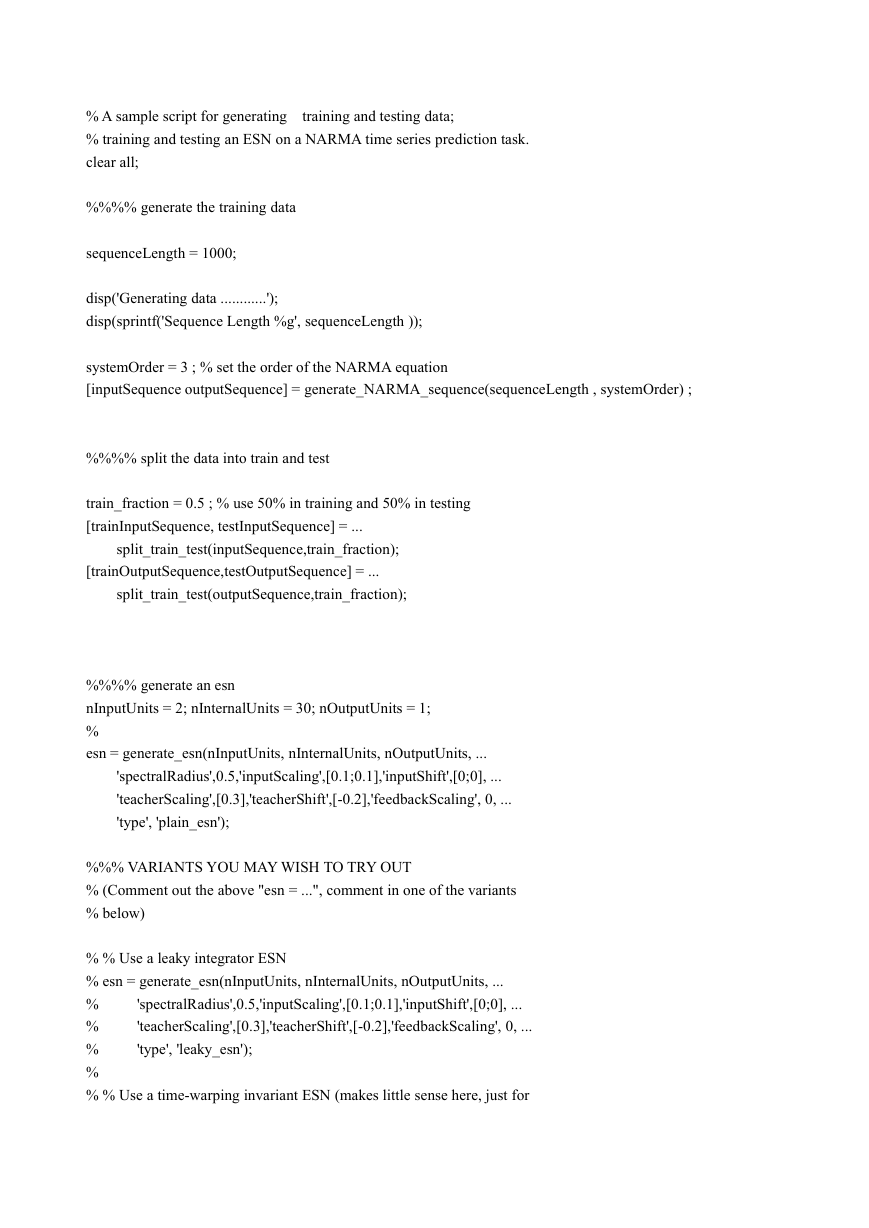
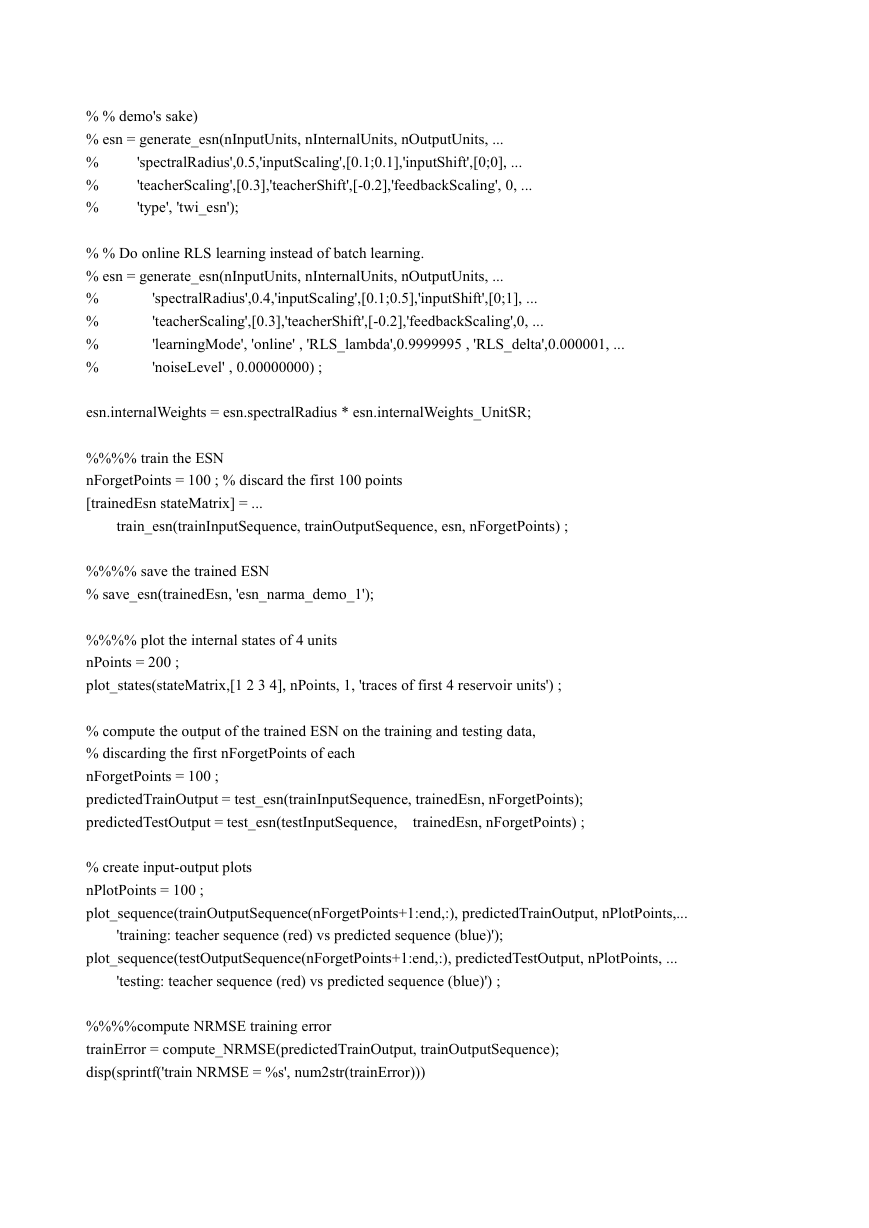
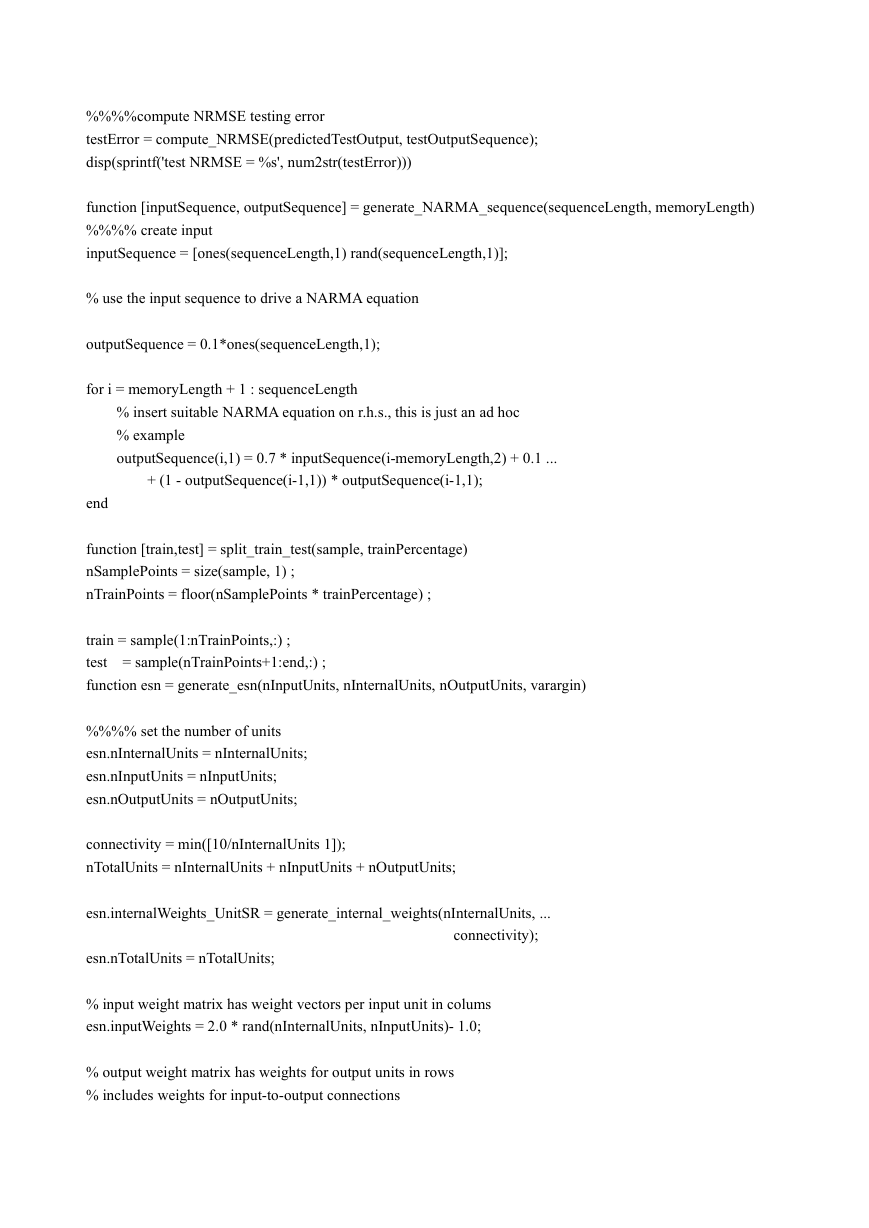
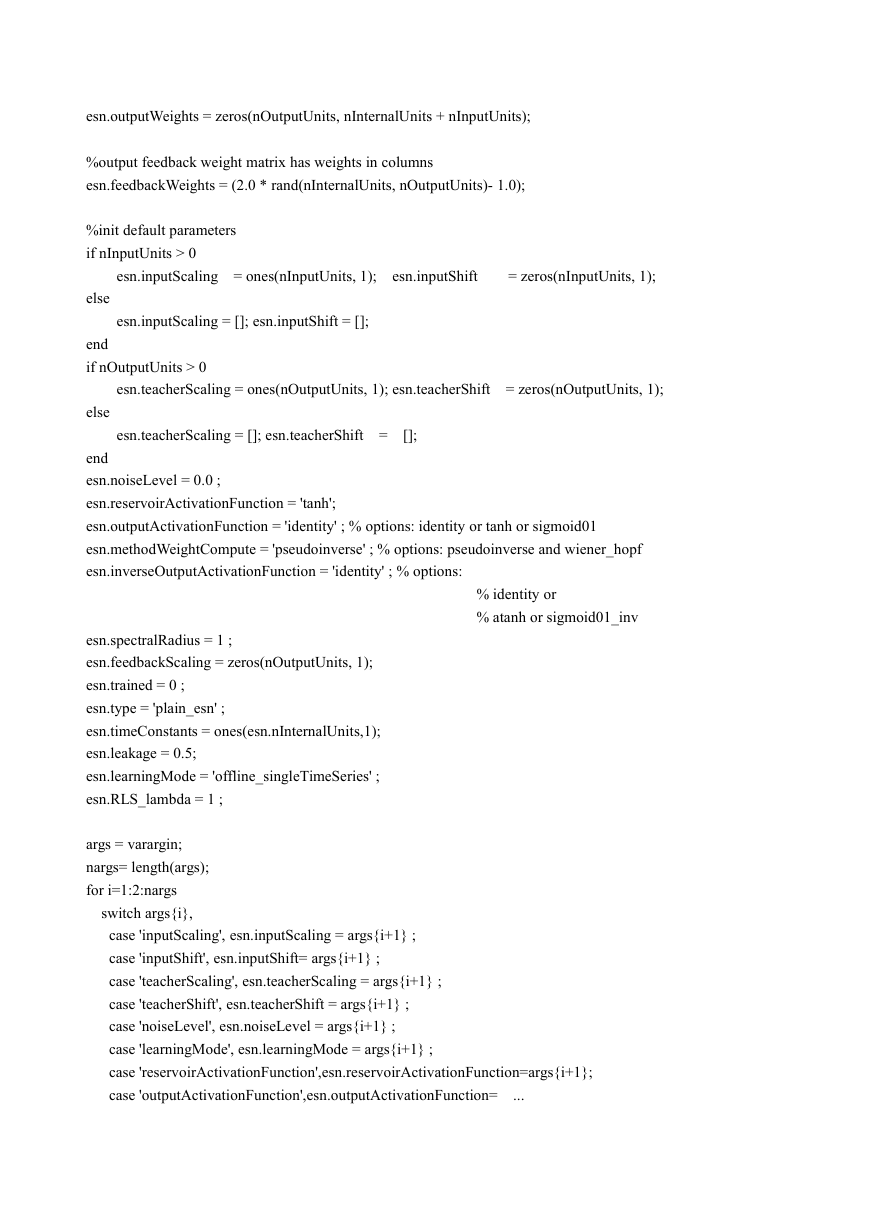
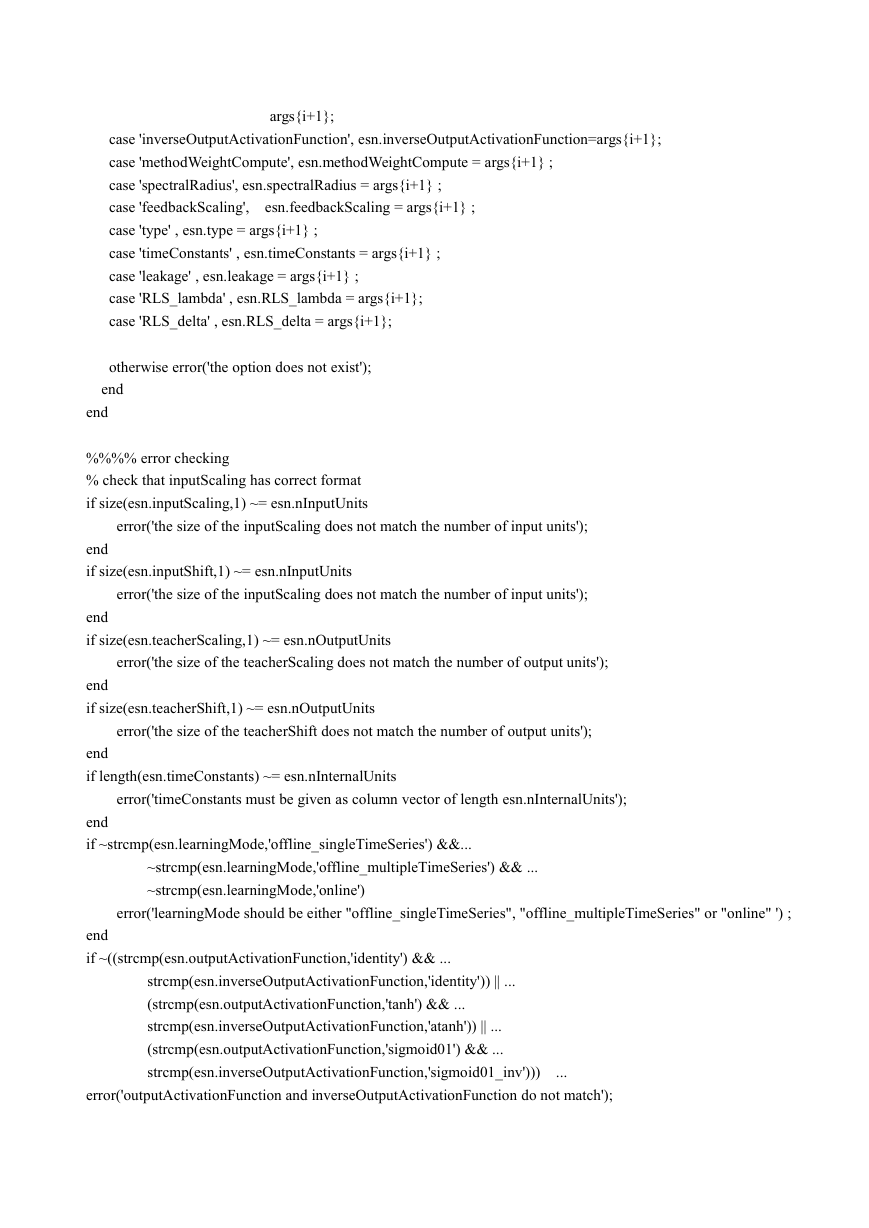

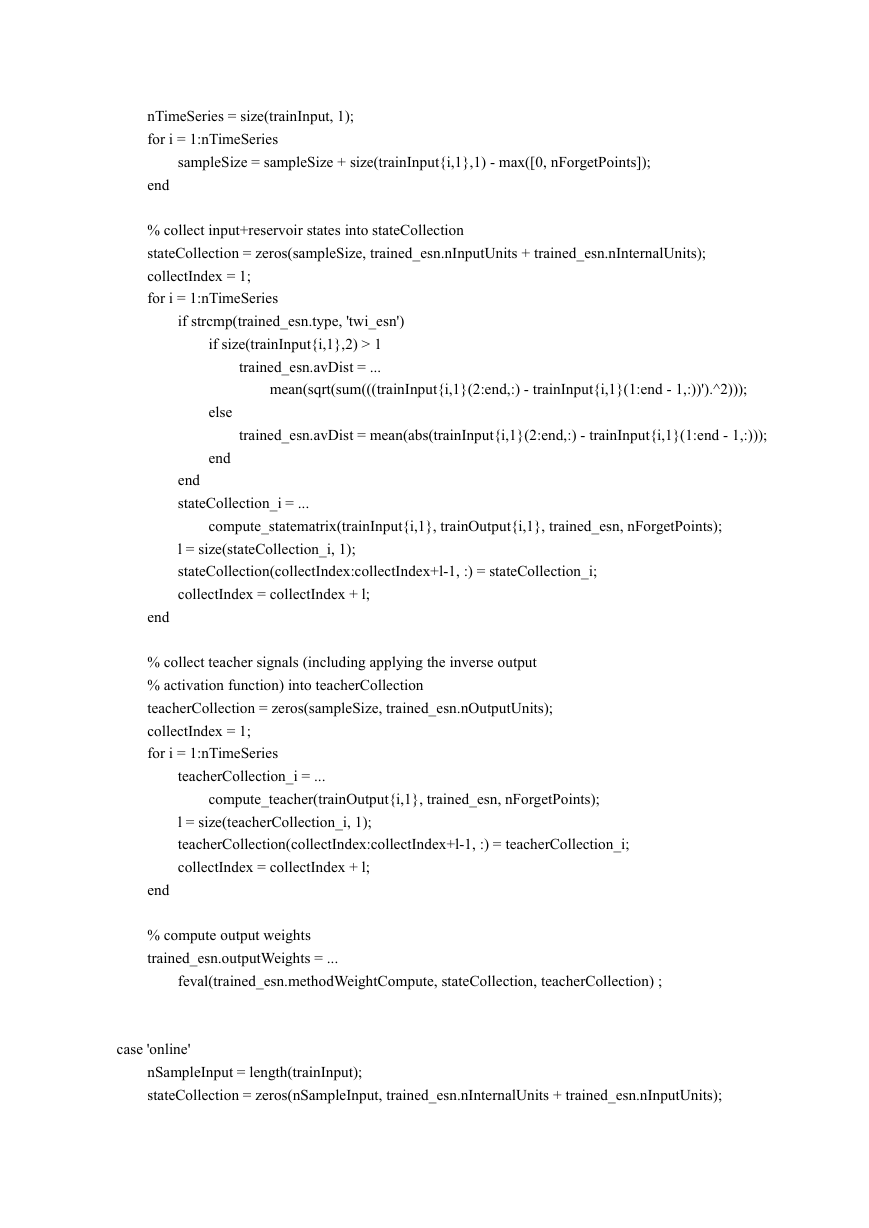
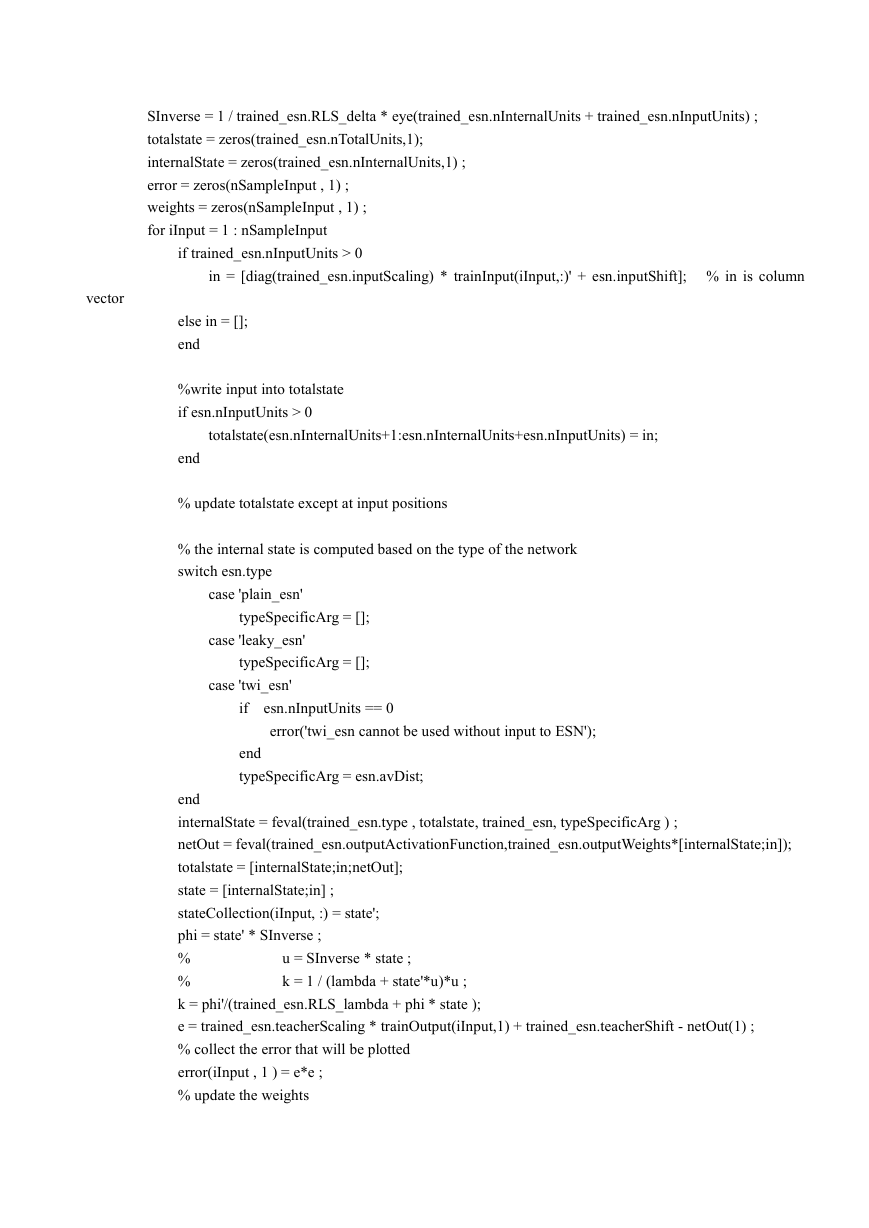








 2023年江西萍乡中考道德与法治真题及答案.doc
2023年江西萍乡中考道德与法治真题及答案.doc 2012年重庆南川中考生物真题及答案.doc
2012年重庆南川中考生物真题及答案.doc 2013年江西师范大学地理学综合及文艺理论基础考研真题.doc
2013年江西师范大学地理学综合及文艺理论基础考研真题.doc 2020年四川甘孜小升初语文真题及答案I卷.doc
2020年四川甘孜小升初语文真题及答案I卷.doc 2020年注册岩土工程师专业基础考试真题及答案.doc
2020年注册岩土工程师专业基础考试真题及答案.doc 2023-2024学年福建省厦门市九年级上学期数学月考试题及答案.doc
2023-2024学年福建省厦门市九年级上学期数学月考试题及答案.doc 2021-2022学年辽宁省沈阳市大东区九年级上学期语文期末试题及答案.doc
2021-2022学年辽宁省沈阳市大东区九年级上学期语文期末试题及答案.doc 2022-2023学年北京东城区初三第一学期物理期末试卷及答案.doc
2022-2023学年北京东城区初三第一学期物理期末试卷及答案.doc 2018上半年江西教师资格初中地理学科知识与教学能力真题及答案.doc
2018上半年江西教师资格初中地理学科知识与教学能力真题及答案.doc 2012年河北国家公务员申论考试真题及答案-省级.doc
2012年河北国家公务员申论考试真题及答案-省级.doc 2020-2021学年江苏省扬州市江都区邵樊片九年级上学期数学第一次质量检测试题及答案.doc
2020-2021学年江苏省扬州市江都区邵樊片九年级上学期数学第一次质量检测试题及答案.doc 2022下半年黑龙江教师资格证中学综合素质真题及答案.doc
2022下半年黑龙江教师资格证中学综合素质真题及答案.doc